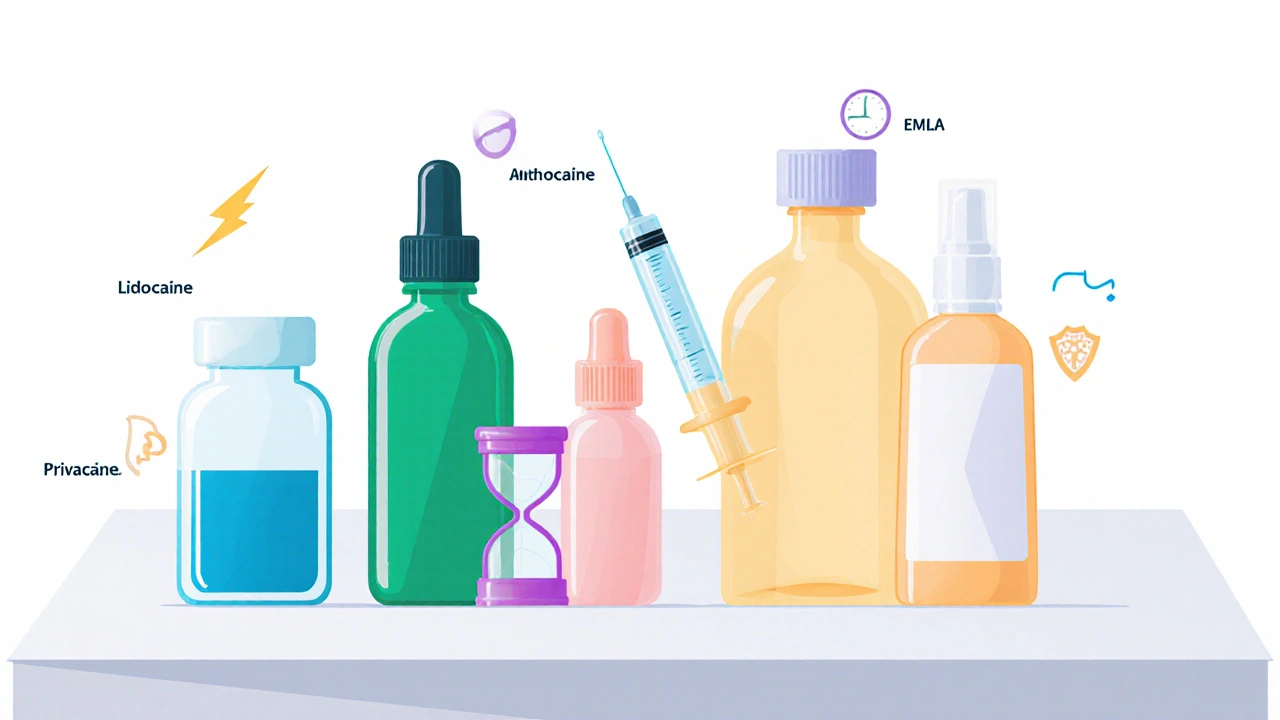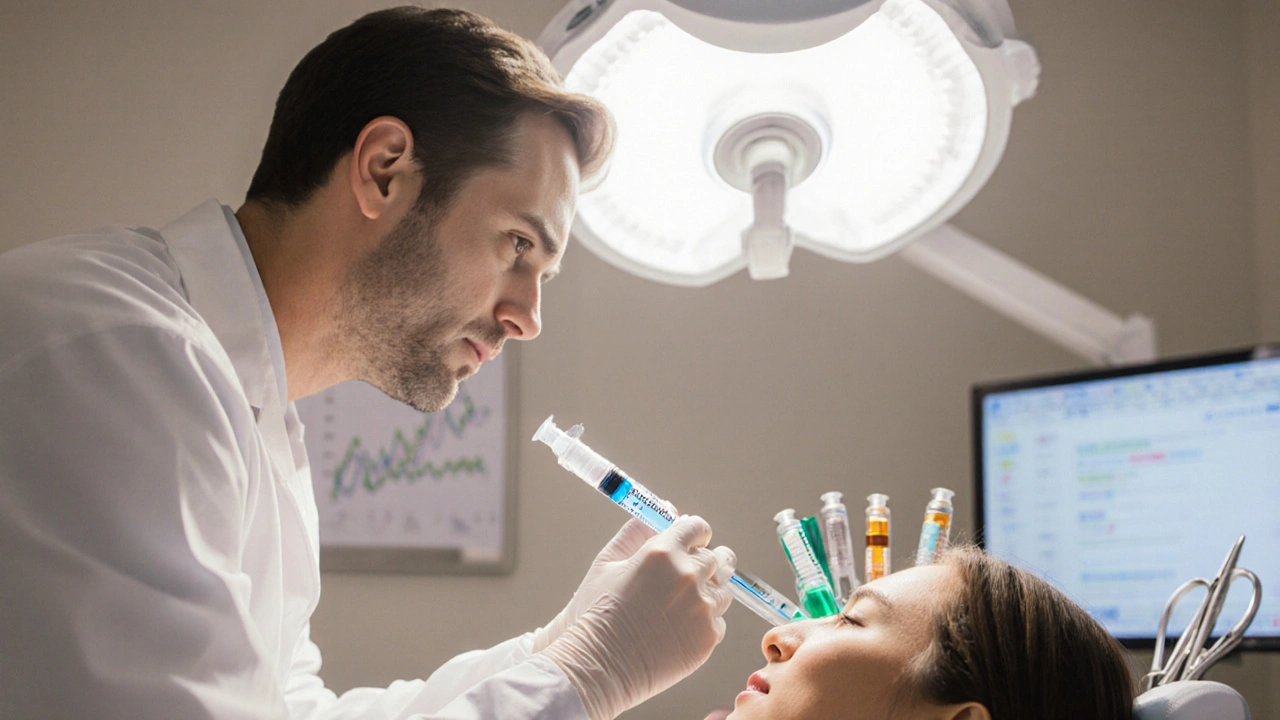Local Anesthetic Comparison Tool
About This Tool
This interactive tool compares key attributes of Xylocaine (Lidocaine) and other local anesthetics to help healthcare professionals and patients understand their differences.
How to Use
Select a drug from the dropdown below to see detailed information about its properties and uses. Compare multiple drugs side-by-side using the comparison table.
Side-by-Side Comparison Table
| Drug | Onset Time | Duration | Potency | Route | Main Uses | Major Side Effects | Contraindications | Price (2025) |
|---|
Key Takeaways
- Xylocaine (Lidocaine) offers a fast onset and moderate duration, making it a go‑to for many dental and minor surgical procedures.
- Long‑acting agents like Bupivacaine are better for extended post‑operative pain control but carry higher cardiac risk.
- Short‑acting topical options such as Benzocaine are useful for surface numbing but lack depth.
- Combination creams (EMLA) provide broader skin coverage but take longer to work.
- Cost, route of administration, and patient‑specific factors (allergies, heart health) should drive the final choice.
When you sit in the dentist’s chair or need a quick numbing shot for a minor wound, the drug on the tray can make a big difference in comfort and safety. Lidocaine is a widely used local anesthetic that goes by the brand name Xylocaine. It works by blocking sodium channels in nerve cells, which stops pain signals from reaching the brain. But lidocaine isn’t the only option. Several alternatives offer different onset speeds, durations, and safety profiles. This guide breaks down the most common rivals, shows how they stack up against Xylocaine, and helps you decide which one fits your needs.
How We Compare Local Anesthetics
To keep the comparison fair, we look at the same set of attributes for every drug:
- Onset time - how quickly numbness begins.
- Duration - how long the effect lasts.
- Potency - concentration needed for effective block.
- Typical route - injection, topical spray, cream, etc.
- Common clinical uses - dental, dermatologic, orthopedic, etc.
- Side‑effect profile - nerve toxicity, cardiac risks, allergic reactions.
- Contraindications - patient conditions that rule out use.
- Price range (US, 2025) - per 10ml vial or per package.
Side‑by‑Side Comparison
| Drug | Onset | Duration | Potency (Typical %) | Route | Main Uses | Major Side Effects | Contra‑indications | Price (2025) |
|---|---|---|---|---|---|---|---|---|
| Xylocaine (Lidocaine) | 1-5min (infiltration) | 30min - 2h | 0.5-2% | Injection, topical gel | Dental, minor surgery, nerve blocks | Transient CNS tingling, rare methemoglobinemia | Severe heart block, known hypersensitivity | $4-$8 per vial |
| Bupivacaine | 5-10min | 4-8h | 0.25-0.5% | Injection | Orthopedic surgery, epidural, prolonged blocks | Cardiac arrhythmias, CNS depression | Pre‑existing heart disease, high dose | $12-$20 per vial |
| Prilocaine | 2-5min | 1-3h | 0.5-2% | Injection, topical cream | Dental, dermatologic procedures | Methemoglobinemia (high doses) | G6PD deficiency, anemia | $5-$9 per vial |
| Articaine | 1-3min | 1-2h | 0.5-4% | Injection (often with epinephrine) | Dental, especially mandibular blocks | Rare nerve injury, allergic reactions | Known articaine allergy, severe liver disease | $8-$14 per vial |
| Benzocaine | 30-60sec (topical) | 5-10min | 5-20% | Topical spray, lozenge | Oral mucosa, minor surface procedures | Methemoglobinemia (especially in children) | Infants, G6PD deficiency | $2-$4 per package |
| EMLA Cream (Lidocaine+Prilocaine) | 30-60min (apply) | 1-2h after removal | Lidocaine2% / Prilocaine2% | Topical cream | Skin grafts, IV cannulation, minor dermatologic procedures | Methemoglobinemia (high dose), skin irritation | Infants <12months, severe anemia | $10-$18 per tube |

In‑Depth Profiles
1. Xylocaine (Lidocaine)
Lidocaine is a synthetic amide‑type local anesthetic that first hit the market in the 1940s. Its rapid onset (as quick as one minute for infiltration) and moderate duration make it versatile. It can be mixed with epinephrine to prolong effect and reduce bleeding. Common concentrations are 0.5% for topical gels and 1-2% for injections. Side effects are usually mild-temporary tingling or a metallic taste-but high systemic levels can cause seizures or cardiac depression.
2. Bupivacaine
Bupivacaine is known for its long duration, lasting up to eight hours. It’s an amide like lidocaine but binds more tightly to sodium channels, which explains the prolonged block. Because it stays in the body longer, clinicians watch the dose closely to avoid cardiotoxicity. It’s the drug of choice for postoperative pain control after orthopedic surgeries.
3. Prilocaine
Prilocaine sits between lidocaine and bupivacaine in terms of duration. It’s less vasodilatory, so it’s often used without epinephrine. The main caution is methemoglobinemia when large doses are used, especially in children. For dental fillings, a 2% solution works well.
4. Articaine
Articaine contains a thiophene ring that increases lipid solubility, allowing it to penetrate bone more efficiently. That’s why many dentists prefer it for mandibular blocks. It’s typically supplied as a 4% solution with epinephrine. Though rare, there have been reports of higher nerve injury rates compared to lidocaine, so clinicians assess risk case‑by‑case.
5. Benzocaine
Benzocaine is an ester‑type anesthetic used only for surface numbing. It’s cheap and works within seconds, but it never reaches deeper tissues. Overuse, especially in infants, can trigger methemoglobinemia-a serious drop in blood’s oxygen‑carrying capacity.
6. EMLA Cream (Lidocaine+Prilocaine)
EMLA Cream blends lidocaine and prilocaine at equal 2% concentrations. The formulation creates a depot in the stratum corneum, releasing the anesthetic slowly. It’s ideal for IV cannulation or skin graft donor sites, but you need to apply it at least half an hour before the procedure.
Best‑Fit Scenarios
- Fast, short‑term dental work: Xylocaine (Lidocaine) 2% with epinephrine.
- Long‑lasting postoperative pain after orthopedic surgery: Bupivacaine 0.25%.
- Surface numbing of the mouth or throat: Benzocaine lozenge or spray.
- Skin procedures needing a wide‑area numbing: EMLA Cream applied 45min prior.
- Mandibular block where bone penetration matters: Articaine 4%.
Practical Tips & Common Pitfalls
- Always calculate maximum safe dose based on patient weight (e.g., lidocaine 4.5mg/kg without epinephrine).
- When mixing lidocaine with epinephrine, watch for tachycardia in patients with hyperthyroidism.
- Avoid using benzocaine on infants or patients with G6PD deficiency.
- For prolonged blocks, consider adding a small dose of bicarbonate to reduce injection pain.
- If you see gray‑blue skin after a topical anesthetic, suspect methemoglobinemia and seek emergency care.
Frequently Asked Questions
Can I use lidocaine if I have a heart condition?
Lidocaine itself is relatively safe for most cardiac patients, but formulations with epinephrine can raise heart rate and blood pressure. If you have arrhythmias or uncontrolled hypertension, ask your doctor whether a plain lidocaine solution is appropriate.
Why does Bupivacaine take longer to work?
Bupivacaine binds more tightly to sodium channels and is more lipophilic, so it stays in nerve membranes longer. The stronger binding slows the onset but extends the duration, which is why it’s chosen for surgeries that need hours of pain relief.
Is EMLA safe for children?
EMLA is approved for children older than one year. For infants under 12months, the risk of methemoglobinemia rises sharply, so clinicians avoid it in that age group.
How do I know if I’m allergic to lidocaine?
True allergic reactions are rare. Most “sensitivity” is a local irritation. An allergy usually shows as hives, swelling, or difficulty breathing within minutes of injection. If you suspect it, stop the procedure and seek medical help.
Which anesthetic is cheapest for a routine dental filling?
Generic lidocaine (Xylocaine) costs about $4-$8 per 10ml vial, making it the most economical choice for most dental offices. Alternatives like articaine or bupivacaine are pricier and usually reserved for specific indications.

Next Steps
If you’re a patient, talk to your dentist or surgeon about which anesthetic matches your health profile and the procedure’s length. If you’re a clinician, review the table above, check the max dose limits, and consider combining agents (e.g., lidocaine+epinephrine) for a balanced onset and duration. Always document any prior reactions and keep emergency equipment handy when using longer‑acting agents like bupivacaine.


Rashi Shetty
October 5, 2025 AT 01:12While the table succinctly lists the pharmacokinetic parameters, it glosses over the clinical implications of lidocaine’s metabolic profile 😊. The rapid onset of Xylocaine makes it indispensable in dental practice, yet the moderate duration demands careful timing when transitioning to postoperative analgesia. Moreover, practitioners often overlook the subtle CNS tingling reported in high‑concentration infiltrations, which can be mitigated by incremental dosing. In contrast, agents such as bupivacaine, though slower to set in, provide prolonged coverage that may reduce the need for supplemental analgesics. Ultimately, the choice hinges on balancing speed, safety, and cost‑effectiveness 📈.
Queen Flipcharts
October 18, 2025 AT 14:07The essence of anesthetic selection transcends mere numbers; it reflects a nation’s commitment to safeguarding its citizens’ health. One must consider not only the pharmacodynamics but also the strategic allocation of resources that fortify our medical infrastructure. Lidocaine, with its reliable performance, embodies a pragmatic approach befitting a resilient populace. Conversely, embracing newer, longer‑acting agents without rigorous oversight risks undermining the very fabric of public safety. Therefore, prudence dictates that we prioritize proven, universally accessible solutions.
Yojana Geete
November 1, 2025 AT 02:03Oh my god the whole thing is a circus the way they dump a wall of data and expect us to read it all I mean who even has the patience for a table that reads like a novel the drama of choosing between lidocaine and bupivacaine is practically a soap opera watch the stakes rise as the heart‑monitor beeps and the dentist sighs
Jason Peart
November 14, 2025 AT 14:58Hey buddy, I get why the quick kick‑in of lidocaine is a lifesaver for dental work – it’s like a friendly hand on your shoulder when you’ve got a needle waiting 😅. If you’re looking for something that sticks around longer, bupivacaine can be your backstage crew, but remember it can be a bit sCary for the heart if you overdo it. Always chat with your doc about any past reactions, especially if you’ve had weird tingling before. And don’t forget the cheaper options like articaine that blend speed and potency without breaking the bank. Stay safe and keep that smile bright!
Hanna Sundqvist
November 28, 2025 AT 03:54They don’t want you to know that the big pharma lobby pushes lidocaine because it’s easier to control than the newer agents.
Jim Butler
December 11, 2025 AT 16:49Excellent overview! The author has distilled a complex subject into an accessible format, which is especially valuable for clinicians juggling multiple cases 🚀. Not only does the comparison highlight onset and duration, but it also flags the nuanced cardiac risks associated with bupivacaine – a detail that can save lives. The inclusion of price ranges adds a practical dimension often omitted in academic texts 💰. Overall, this tool empowers evidence‑based decision‑making and encourages cost‑effective care.
Ian McKay
December 25, 2025 AT 05:44The table is presented clearly; however, the omission of units for onset and duration could cause ambiguity. Additionally, the phrase “major side effects” should be preceded by a colon for proper punctuation. It would be advisable to standardize capitalization across all drug names.